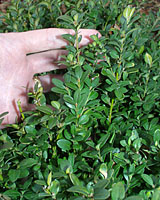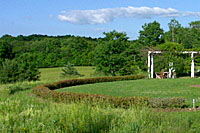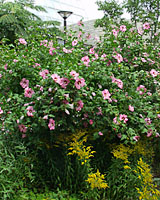Terry L. Ettinger Horticulture Consulting Services
Meeting The Needs Of Today With A Vision For The Future
Special Topics
Deer in Landscapes and Gardens
Deer-Resistant Plants
 Since
the late 1980's many "deer-resistant plant" lists have been published.
I'll admit that I've been lulled into a false sense of security more
than once by these lists. For example, don't believe for a second
that boxwood, at right, is resistant to feeding damage in
neighborhoods where deer populations are high!
Since
the late 1980's many "deer-resistant plant" lists have been published.
I'll admit that I've been lulled into a false sense of security more
than once by these lists. For example, don't believe for a second
that boxwood, at right, is resistant to feeding damage in
neighborhoods where deer populations are high!
Unfortunately, research suggests that when deer populations rise above fifty or sixty animals per square mile there are very few plants they won’t eat. And, because they tend not to move too far in search of food, their palate increases as they become hungrier and food sources become more scarce.
Deer also tend to be unpredictable as to what they’ll eat depending upon where they live.
In some neighborhoods where food is plentiful, deer often walk right past landscape beds filled to overflowing with favorite plants. Meanwhile, only a couple of blocks away, the same plants may be gnawed right back to the trunk.
 Even more frustrating is that deer may leave plants untouched for several years, then eat them to the ground
practically overnight for no apparent reason! This will likely never
be the case with yews (Taxus), however, as even in the very
rural setting pictured here, they gorge themselves on the
brown-tinged arc of this favorite food after crossing a wide-open
field!
Even more frustrating is that deer may leave plants untouched for several years, then eat them to the ground
practically overnight for no apparent reason! This will likely never
be the case with yews (Taxus), however, as even in the very
rural setting pictured here, they gorge themselves on the
brown-tinged arc of this favorite food after crossing a wide-open
field!
 Given this unpredictable nature, it’s best to rely on plants that
can recover relatively quickly, even after being heavily browsed.
Just a couple of examples include rose-of-Sharon, at
right, and
rugosa roses. For additional recommendations, click on
the "Sources for More Information" link in the upper right
corner of this page.
Given this unpredictable nature, it’s best to rely on plants that
can recover relatively quickly, even after being heavily browsed.
Just a couple of examples include rose-of-Sharon, at
right, and
rugosa roses. For additional recommendations, click on
the "Sources for More Information" link in the upper right
corner of this page.